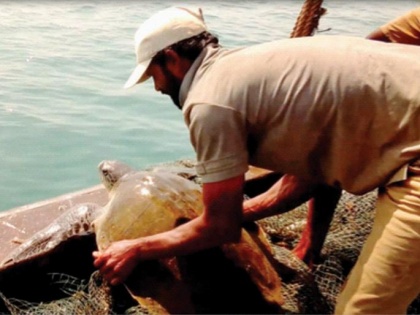Maharashtra: Olive Ridley Turtle nesting sites and hatching increases
By Lokmat English Desk | Published: June 18, 2021 11:34 AM2021-06-18T11:34:55+5:302021-06-18T11:36:49+5:30
Efforts are being taken for the conservation of coastal turtles in Maharashtra and they seem to be working. The ...

Maharashtra: Olive Ridley Turtle nesting sites and hatching increases
Efforts are being taken for the conservation of coastal turtles in Maharashtra and they seem to be working. The Olive Ridley Turtle nesting sites and hatching along Maharashtra’s coastline have increased in 2020-21 as compared to 2019-20. At 23,706 hatchlings, this year’s count is nearly twice as much as 2020 when 12,149 hatchlings were released.
Sea turtles nest in many places on the west coast of India. Of the seven sea turtle species found in the world, four are known to nest on Indian mainland and in the Andaman, Nicobar and Lakshadweep islands.Of these, only Olive Ridley turtles are found nesting on the shores of Maharashtra. Olive Ridley turles nest in the coastal areas of Raigad, Ratnagiri, Sindhudurg district.
In the past, these nests have faced major threats due to poaching, besides attack on hatchlings by dogs and other animals. A tortoise conservation campaign has been undertaken with the help of Maharashtra Forest Department, Sahyadri Nature Friends and locals. Under this campaign, a network of hatcheries to conserve the sea turtles was set up in the coastal areas of Maharashtra.
The Turtle Festival started in 2006 at Velas, Anjarle, Ratnagiri.In 2020 and 2021, Kandalvan Pratishthan organized the Turtle Festival online. Since 2019, Kandalvan Pratishthan has been paying honorarium to the coastal volunteers in Raigad, Ratnagiri and Sindhudurg. However, due to lockdown, very few tourists could visit the beaches, a marine biologist said.
The sea turtle conservation programme includes locating Olive Ridley turtle nesting sites, excavation, and relocation of eggs to the hatchery site. The hatchery is protected with a garden fencing net for protecting eggs from predators, flooding, and poaching. Subsequently, the turtle hatchlings coming out of these nests are released safely to the sea by the local beach managers and volunteers.
From 2018, Kandalvan Cell and Kandalvan Pratishthan have started implementing public awareness programs in the coastal districts of the state. Under this, the volunteers are trained on the location of the hatchery, finding the turtle's nest, bringing the eggs to a safe hatchery. - Virendra Tiwari, Upper Principal Chief Conservator of Forests (Kandalvan) and Executive Director, Mangroves Foundation
Open in app